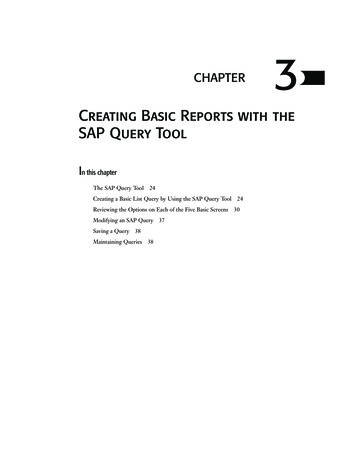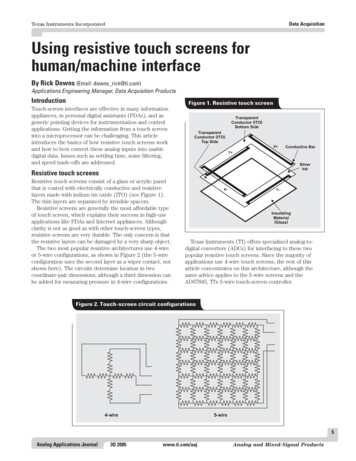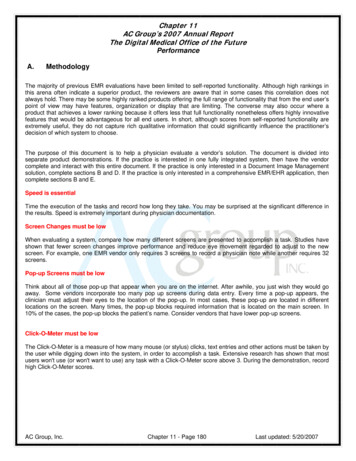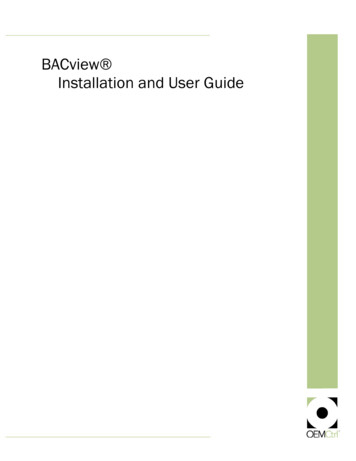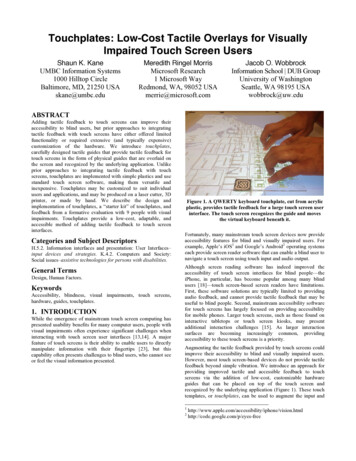
Transcription
Life Behind the Screens ofParents, Tweens, and TeensThe 2022 McAfee Connected Family Study—Australia
REPORTExecutive SummaryMcAfee’s first-ever Global Connected Family Study furthers our commitment tokeeping families safe in a connected world, through understanding, education,and empowerment. In this ten-country study, we spoke with parents and theirchildren to understand how they connect and protect themselves online.Here, we uncovered universal beliefs about online protection, along with severalnuances, all of which pinpointed tensions between parents and children when itcomes to staying safe while enjoying life online.The complete findings can be found in our full global report, available here.In this regional report, we’ll take a look at findings specific to Australia—where families differed from global trends and instances where they setsome of their own. 2Comparison One: Mobile MaturityComparison Two: Top DevicesComparison Three: Concern and Frequency of CyberbullyingComparison Four: Account Theft and Financial Information LeaksComparison Five: Gendered Protection BiasLife Behind the Screens of Parents, Tweens, and Teens—Australia
REPORTUnique Trends in AustraliaChildren in Australia report a high rate of cyberbullying, the second highest in theworld, and express strong concerns about social media’s impact on bullying.Second only to the U.S., Australia reported the highest rate of cyberbullying in all countries studied andtied the U.S. when it came to the parental awareness gap that their child is being cyberbullied (4%).Parents’ Knowledge and Children’s Experiencewith CyberbullyingAustralian Children, Total 4Australian Parents, Total24% ( 7)Point gapin parentknowledge20% ( 6)Australian childrensay they haveexperiencedcyberbullying in thepast, compared to17% of childrengloballyAustralian parentsreport that their childhas been exposed tocyberbullying in thepast, compared to14% of parents globallyC15A. Have you been exposed to Cyber bullying in the past? (Base: Australian children, n 1,106)PC15A. Has your child been exposed to Cyber bullying in the past? (Base: Australian parents, n 1,441)Parents and children in Australia further expressed their concerns about cyberbullying more stronglythan any other nation. They both said that posting on social media could lead to bullying or abuse at arate of 9% higher than the global average. Responses from girls were the strongest, as were responsesfrom teens aged 15 and up.Perception that Posting on Social Media and Public Forums Could Expose Children to Bullying/Abuse 9 966%ParentsYes (66%)No (28%)Don’t Know nYes (58%)No (33%)Don’t Know (9%)Australian Parents and Children,by Child Gender and AgeParentsAustralian Children, TotalChildrenAustralian Parents, Total62%55%Boys68%63%Girls62%55%Age10-14PC15B. Do you think posting on social media like Facebook, Tiktok or other public forums could expose your child to bullying or abuse? (Base: Australian parents, n 1,441)C15B. Do you think posting on social media like Facebook, Tiktok or other public forums could expose you to bullying or abuse? (Base: Australian children, n 1,106)3Life Behind the Screens of Parents, Tweens, and Teens—Australia68%68%65%60%Age15-16Age17-18
REPORTComparison One: Mobile MaturityChildren in Australia report using mobile devices at an early age just as otherchildren do and continue to increase their smartphone usage largely in step withthe rest of the world.As mentioned above, children worldwide reported a major uptick in mobile device usage as theyapproached their mid-teens. Our study found that children hit their online stride right about the samepoint in life, between 15 and 16 years old. At this point, their mobile usage jumps significantly, so much sothat it approaches levels that they will carry into adulthood.Yet their connected lives start much earlier, with smartphones and mobile devices leading the wayonline exposing them to the broader internet full of apps, chats, entertainment, and social media—along with the benefits and risks nearly right away.Mobile/Smartphone Device UsageChildren, Total by Age and CountryChildren, Total by Age 14points 90%93%95% 96%99%83%76%Age 10-1498% 97%91% 93%83%83%Age 10-14Age 15-16Age 17-1888% 90%89%94%Age 17-18Average by Country93%75%74%Age apan96%89%86%85%80%80%77%89%93%68%86%69%Australia Canada76%87%83%74%91%65%U.S.73% C1. Which of the following devices do you use? (Base: Children, n 12,057)For children in Australia, this trend holds true when compared to other children around the world. Ofnote, smartphone use at a younger age trailed well behind the international average. However, aschildren entered the mid-teens and then approached adulthood, the figures fell in line with their peersaround the globe.4Life Behind the Screens of Parents, Tweens, and Teens—Australia
REPORTComparison Two: Top DevicesWhile smartphones come in first for parents and children alike, the second-mostimportant device differs—and differs in how it is viewed when keeping connectedwith family.Parents and children in Australia say that their mobile device is the most important one in their life.Parents placed mobile in their top two with their smartphone at 65% followed their computer or laptopat 41%. Tweens and teens put their smartphone at the top of the list as well, yet at 71%, followed by theirgaming console at 65%.Tweens and young teens in Australia fall just below the average in gaming console usage, with 51% ofthem saying they play on connected game systems, 2% lower than the rest of the world.Gaming Console Device UsageChildren, Age 10-14Children, Age 10-14 by Country60%58%58%56%56%56%51%48%53%47%34%Children age10-14 use agamingconsoleUKGermanyC1. Which of the following devices do you use? (Base: Children age 10-14, n 7,571)5Life Behind the Screens of Parents, Tweens, and zilCanadaIndia
REPORTOf further interest is that children said their gaming console is their second-most important devicefor keeping connected with family, with 38% expressing this, in line with the global average of 40%.Meanwhile, parents appear to place a much lower importance on the gaming console as a way toconnect with family at 21%.Perceived Importance of Gaming Consoles when Connecting with FamilyGlobalParents, TotalGlobalChildren, Total 16AustralianParents, Totalabove parentimportance24%TotalImportant 17above n, Total38%21%TotalImportantTotalImportantPerhaps unsurprisingly, both parents and children said the smartphone was the most important devicefor maintaining family connections, with parents at 59% and children at 63%—both of which came veryclose to the global norm, which was 59% for parents and 64% for children.Tweens and young teens inAustralia fall just below theaverage in gaming console usage.6Life Behind the Screens of Parents, Tweens, and Teens—Australia
REPORTComparison Three: Concern and Frequency of CyberbullyingWhile children claim that the smartphone is the most important device they own,risks come with that, including early exposure to cyberbullying—well above theglobal average.Both parents and children expressed mixed feelings about posting on social media because it couldpossibly lead to bullying or abuse. Globally, 57% of parents worried about such bullying and abuse onsocial media, while 49% of children said they held the same worry.In Australia, those figures trended higher, with 66% of parents stating their worry, 9% above the globalaverage—and 58% of children saying likewise, also 9% above the global average.Perception that Posting on Social Media and PublicForums Could Expose Children to Bullying or AbuseParents, TotalChildren, TotalParents and Children, by CountryParentsYes (57%)No (35%)Don’t Know (8%)49%ChildrenYes (49%)No (41%)Don’t Know %42%CanadaIndia38%37%35%32%Germany JapanPC15B. Do you think posting on social media like Facebook, Tiktok or other public forums could expose your child to bullying or abuse? (Base: Parents, n 15,156)C15B. Do you think posting on social media like Facebook, Tiktok or other public forums could expose you to bullying or abuse? (Base: Children, n 12,030)These figures trended highest in Mexico, with parents at 78% and children at 61%. Brazil was not farbehind at 67% and 57%. Note the low end of the scale, Germany’s figures were 38% and 35% with Japanat 37% and 32%.As far as exposure to cyberbullying, 24% of children in Australia reported having experienced it at sometime. Globally, children reported a rate of 17%, putting Australia seven points above the global average.Note how this compares to the highest and lowest reported rates, with the U.S. at 28% and Japan at 6%.7Life Behind the Screens of Parents, Tweens, and Teens—Australia
REPORTComparison Four: Account Theft and Financial Information LeaksIn addition to cyberbullying, families reported their experiences with other onlinethreats, indicating issues with online privacy and security—at a slightly higher ratethan the rest of the world.Parents in Australia reported the attempted theft of online accounts at 27% with their children at 17%.There was a slight difference in reporting here, however. When asked if their child had been exposed topossible online account theft, 15% of parents said so—two points lower than what children reported.That 27% figure for parents in Australia is in line with global figures, with the international data puttingparents at 28%. The same holds true for children. The international figure for children is 15%—which is 2%lower than for children in Australia. As for that difference in reporting, 14% of parents worldwide reportedthat their child had been exposed to possible theft—one point lower than what children reported.Attempted Theft of Online AccountsReported %WorldwideParentsWorldwideChildrenBoth parents and children reported leaks of financial information as well, which could include bankinfo, credit or debit card info, or other identifying information. In Australia, 23% of parents said they hadexperienced it at some point in the past—while 12% of children reported the same.Australian parents and children reported this threat at a similar rate to families worldwide, with parents2% higher than the 21% average and children 2% higher than the 10% average.8Life Behind the Screens of Parents, Tweens, and Teens—Australia
REPORTComparison Five: Gendered Protection BiasGlobally, research showed that girls receive more protection and oversight onlinethan boys, often markedly so in Australia, yet boys experience more threatsonline.Using the presence of parental controls software as one measure, girls are protected more than boysworldwide—on both their computers and smartphones. This holds quite true in Australia as well. Oncomputers, 45% of girls have parental controls software installed compared to 35% of boys, a differenceof 10%. The gap is roughly the same on mobile at 9% in favor of girls, with the rates being 34% and 25%,respectively.TotalParent about ChildrenAge 10-14, Total andby %32%India40%U.S.42%38%Canada37% 35%Brazil33%30%GermanyJapan29% 31%15%34%MobileParents of girlsParents of boysMexico49%PC/LaptopParent hasInstalled ParentalControls Softwareon Child’sPC/Laptop orMobile Device31%36%47%41%33%42%30%37% 36%34%25%43%37%35%34%24%26% 24%11%31%18%14%PC7. Which of the following security/privacy precautions have you taken for your child on their PC/laptop? Select all that apply. (Multiple responses allowed) Parental Controls Software (Base: Parents withchildren age 10-14 who use a PC/laptop, n 3,569) PC8. Which of the following security/privacy precautions have you taken for your child on their mobile phone/smartphone? Select all that apply. (Multipleresponses allowed) Parental Controls Software (Base: Parents with children age 10-14 who use a mobile/smartphone, n 5,740)This gap continues as we look at other forms of protection and oversight. This is most notable forgirls aged 15 to 16, their parents are more likely to check their calls and texts at 31%, with boys at 28%.Checking on the websites and apps their child visits or uses showed bias as well at this age. Fifty onepercent of parents said they do so for girls and only 42% for boys.9Life Behind the Screens of Parents, Tweens, and Teens—Australia
REPORTOf note, any such gap should be seen in light of the following: boys worldwide report experiencingthreats online at a rate higher than girls.Experience with AttemptedThefts of Online AccountsChildren, TotalChildren,by Gender15%ChildrenExperience with Leaks ofFinancial Information 6GirlsChildren,by Gender10%Children12%Children, TotalChildren, Totalabovegirls18%Experience with UnauthorizedUse of Personal Data8%BoysGirls 4abovegirls12%Children,by Gender13%ChildrenBoys11%GirlsC16A. Have you been exposed to attempts of theft of your online accounts (gaming, social, etc.) in the past? (Base: Children, n 12,030)C17A. Have you been exposed to leaks of your financial information (bank, credit card, passport or other identifying information) in the past? (Base: Children, n 12,030)C18A. Have you had unauthorized use of your personal data (spam, fraud, attempts to send virus to my contacts) in the past? (Base: Children, n 12,030)In all, this stands as a reminder that all children can stand to benefit from online protection andoversight from their parents.Globally, research showed thatgirls receive more protection andoversight online than boys, oftenmarkedly so in Australia, yet boysexperience more threats online.10Life Behind the Screens of Parents, Tweens, and Teens—Australia 4abovegirls15%Boys
REPORTFor the full 2022 McAfee Connected Family StudyReport, along with its detailed global findings,visit us for a free download. Survey MethodologyIn December 2021 McAfee LLC conducted a study about beliefs and behaviors around digitalparticipation and online protection among members of connected families—as individuals and as afamily unit.Global survey of parents and children, with children answering alongside their parents.Parents and children were surveyed together, with parents answering first and then bringing theirchildren in to consent and answer.These findings represent connected families not collections of individuals.In multiple countries 15,500 parents of children in the age 10–18 participated in the study, as well as morethan 12,000 of their children.The research was conducted between December 13th–29th, 2021 by MSI-ACI via an online questionnaireto 15,500 parents and 12,057 children from 10 countries. About McAfeeMcAfee is a global leader in online protection. We’re focused on protecting people, not devices. Oursolutions adapt to our customers’ needs and empower them to confidently experience life onlinethrough integrated, easy-to-use solutions.For more information about online protection, visit us at mcafee.com/blogs6220 America Center DriveSan Jose, CA 95002888.847.8766www.mcafee.comMcAfee and the McAfee logo are trademarks or registered trademarks of McAfee,LLC or its subsidiaries in the US and other countries. Other marks and brands maybe claimed as the property of others. Copyright 2022 McAfee, LLC.MAY 2022
McAfee's first-ever Global Connected Family Study furthers our commitment to keeping families safe in a connected world, through understanding, education, and empowerment. In this ten-country study, we spoke with parents and their . 3 Life Behind the Screens of Parents Tweens and Teens—Australia. Comparison One: Mobile Maturity




